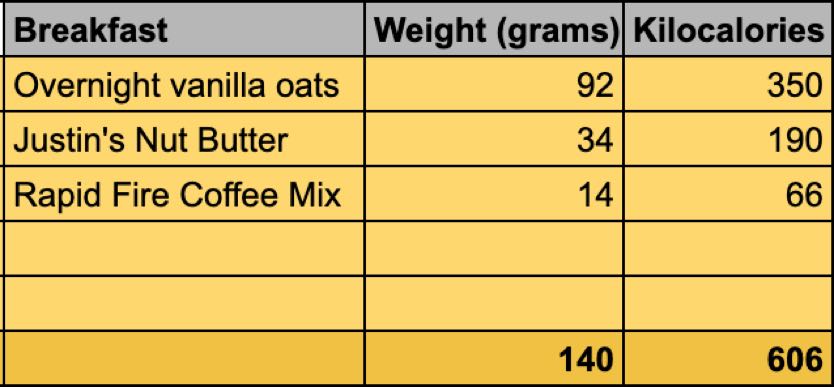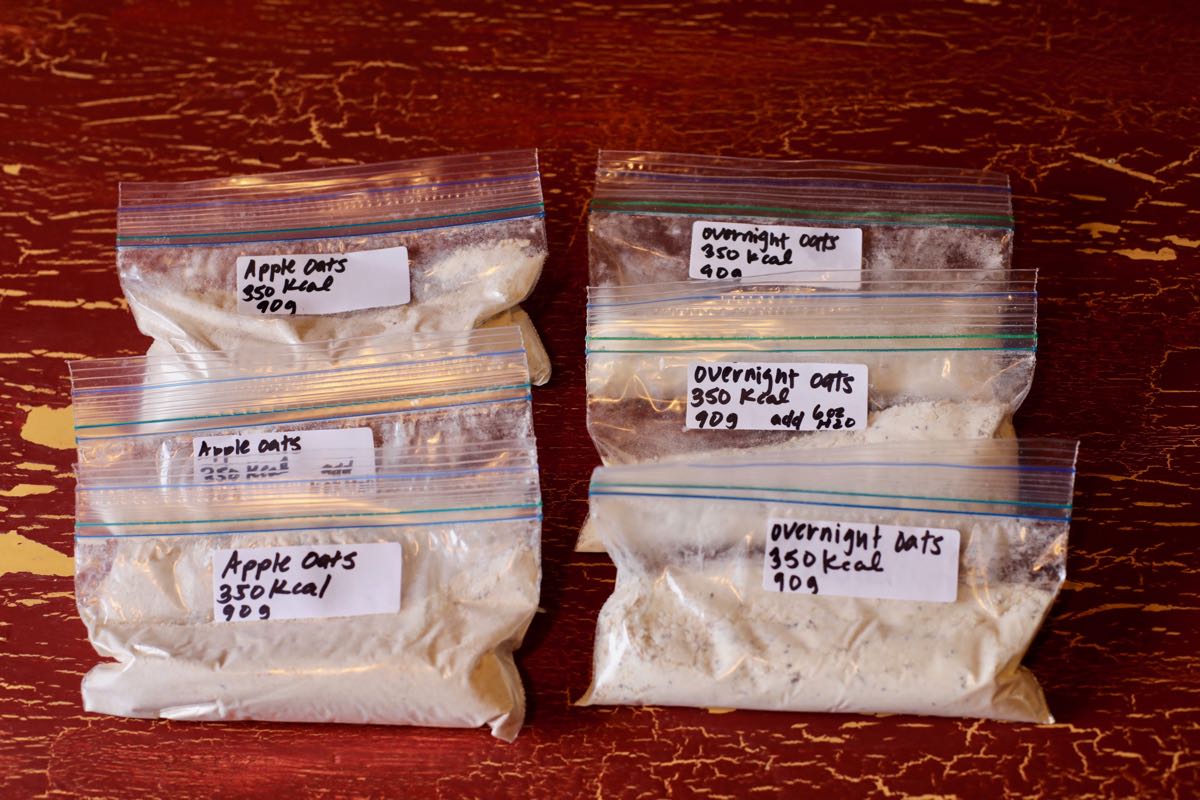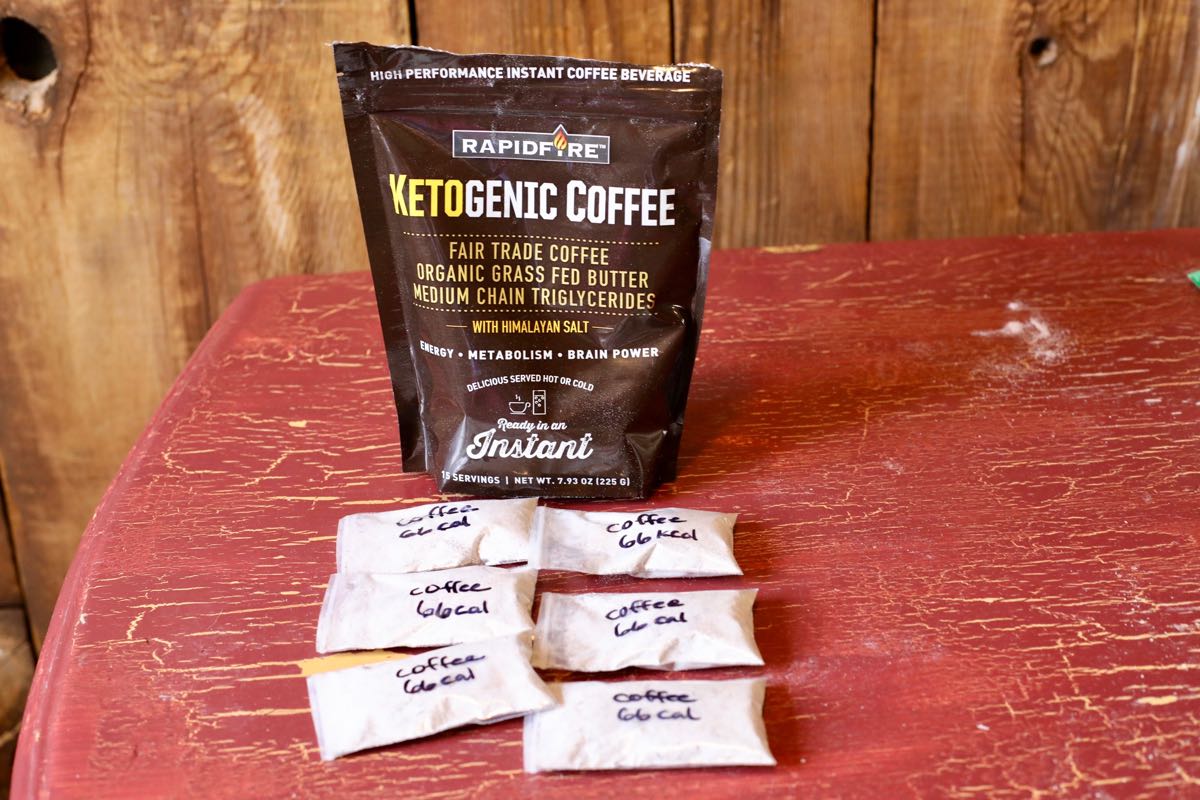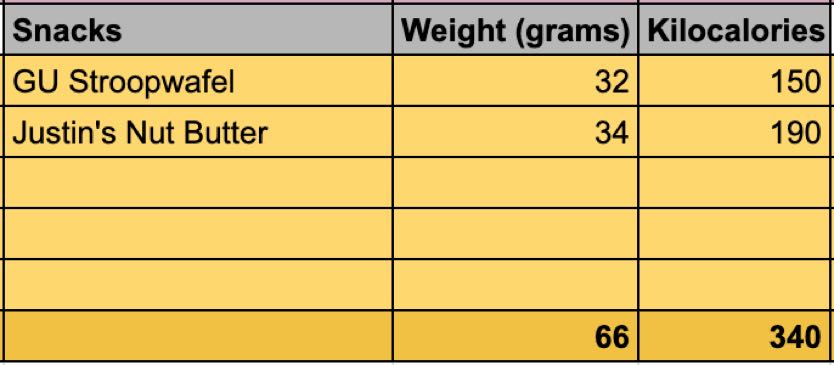So, you want to run the Marathon Des Sables, a seven-day stage race of self-sufficiency in Morocco’s Sahara Desert! Congratulations and welcome to life-changing experience. Between the resources you put into the trip itself and your preparation for it, the Marathon Des Sables (MDS) requires loads of time and money. I have run the MDS six times, so clearly I think that it’s all worth it.
You know that phrase used in construction, ‘Measure twice, cut once?’ As in, prepare ahead of time and make fewer mistakes in the heat of the moment? I have found the same to be true when it comes to prepping for the MDS. The more committed you are to the pre-race and during-race MDS experience, the better it will be. By ‘better,’ I mean that you will feel physically better and have more fun. This goes for preparing your kit, food, training, and logistics. I’ve made mistakes and seen others make them too. Usually, our mistakes could have been prevented with preparation beforehand, though, and that’s what this article is about!
This article is part two of a three-article series where we offer detailed information on how to prepare for and run the MDS. The first article is focused on preparing your kit, which refers to all of the gear you carry and wear during the race. Part three offers recommendations on training and the other logistics that go into preparing for the MDS.
While we write specifically about the MDS experience, a lot of what you’ll find in this article series can be applied in theory to other expedition-length, self-sufficiency stage races, too.
In this article, we begin by talking about the basic principles of preparing your MDS food list, and then dive into detailed recommendations as well as my own 2019 MDS food list.
Marathon des Sables Food Principles
When we talk about MDS food, we mean all the food you’ll eat during the self-sufficiency part of the race. This includes what you eat at camp before and after each racing stage, as well as what you eat while running. Here are the six basic principles I think best guide choosing MDS food:
- Follow the race rules.
- A combination of calorically dense, dehydrated, and carbohydrate-rich foods is queen/king.
- Pre-test everything.
- Bring (a bit) more than 2,000 kilocalories per day.
- You are a study of one.
- Choose foods that don’t require a pot, cup, stove, or fuel (besides the sun).
Follow the race rules.
As you’ll see mentioned a number of times in this article series, there are a lot of rules at the MDS! Thus it’s no surprise that there are several rules about the food we eat at the race. The MDS rules on food attend to three specific issues: a minimum required calorie count, the inclusion of a nutrition label for all food, and no gas stoves allowed at the race.
First, that minimum calorie count. The race organization mandates you to carry a minimum of 14,000 kilocalories (kcals) of food, or a minimum of 2,000 kcals per day. The organization further requires you to maintain a minimum calorie count on the morning of each stage, explained in a chart in the race rules. This includes still having 2,000 kcals when you wake up on the morning of the seventh day/the sixth (charity) stage.
Then, the race rules state that any food you bring that’s out of its original packaging must have the product’s nutrition label. Many people repackage their food into lighter bags and vessels, and if you do be sure to include the nutrition label in your new packaging.
Finally, gas stoves aren’t permitted at the MDS. Some people purchase Esbit fuel tablets and stoves at the MDS store located at the starting-line bivouac, which are allowed at the race. Other people collect and use the very small amount of wood and grass located in the natural environment to make cooking fires. Still others use the radiant heat of the sun to cook their food. And some people eat food that needs no cooking.
A combination of calorically dense, dehydrated, and carbohydrate-rich foods is queen/king.
Throughout this article series, I emphasize the importance of making your MDS pack and everything in it as light as possible. After all, you will lug all of it an estimated 250 kilometers (155 miles) for a week across sand dunes, over mountains, and through oppressive heat. This, of course, includes your food. Your journey to a lightweight food list is founded in choosing foods with decent caloric density and foods that don’t naturally contain much water or that have been dehydrated.
Let us first learn about caloric density, or the amount of energy per unit of weight that food has. In this article, we use kilocalories (kcals) as our energy unit and grams (g) as our weight unit. Foods with high caloric densities contain a lot of calories in a small amount of weight, while low-caloric-density foods don’t. As examples, olive oil is an extremely high-caloric-density food, containing 8.85 kcals/g, while carrots are very low, containing 0.4 kcals/g.
Now, dehydrated foods. As you will come to know very intimately during MDS when you are running with a lot of drinking water between checkpoints, water is heavy! One liter of water weighs one kilogram. Most food contains some water, and some foods contain a lot of it. On the other hand, some food naturally contains very little water, and a lot of food can be dehydrated. Take potatoes, which are made up of 80% water and are, as we all know, quite heavy. If you dehydrate a potato and leave its solid parts, you retain the nutritional value of the potato without having to lug its water around. Many dehydrated foods can be rehydrated just by adding water and sometimes a little heat.
All of this said, if you pack the most calorically dense and water-less foods that exist for MDS, you will end up with foods that you not only may not enjoy but also foods containing an incorrect ratio of macronutrients for your needs as an endurance runner. So, while you should endeavor to choose foods with these qualities, you must also consider what nutrients your body needs for a week of endurance running. That answer, for almost everyone out there, is a good deal of carbohydrates. Carbohydrate is the primary macronutrient that the human body uses as endurance-running fuel and in the basic metabolic processes of life. A significant amount of protein is needed as well, especially to help the body rebuild muscle after running. Fat is the third macronutrient that we need to keep the body humming along. At the MDS, a majority of your food should be carbohydrates, while the rest is split between protein and fat. My ratio of carbohydrates to protein to fat is skewed more toward carbohydrates at MDS than during a typical day at home. (This article doesn’t address the nutritional needs of fat-adapted endurance runners at the MDS.)
Pre-test everything.
I brought a certain kind of bar to my first MDS in 2009. At the time, I used these bars for hiking, backpacking, and trail running in normal conditions. But I never tested them in the heat expected at MDS. In fact, I never even thought about doing this. Turns out, I couldn’t eat these bars in the heat, whether I was running or simply sitting around the MDS bivouac. I had 10 of them, what amounted to about 2,500 kcals of my weekly food ration, that were useless to me because I didn’t test them ahead of time in MDS conditions.
Another general anecdote, a mistake I see MDS runners make. Many runners use dehydrated backpacking or similar meals because they are very light, and this is an excellent plan. However, some people have never eaten dehydrated food at all, while others haven’t tested their particular meals in MDS conditions. Some runners end up at MDS with food that their stomachs or taste buds don’t enjoy, and are stuck.
Don’t make the same mistake I and other people have! Pre-test all of your food in the expected environmental conditions. This means, test your running food while training in heat, and test your other food in hot, dry conditions. Most of us don’t live in Sahara Desert-like environments, but its conditions can be replicated in saunas, by wearing a lot of clothes outside, or by putting a heater in a bathroom or closet.
In my opinion, testing your food ahead of time comes down to testing it against three parts of your body:
- Your taste buds – The food needs to taste good in MDS conditions.
- Your gastrointestinal tract – Does the food digest easily and comfortably, including all the way through to your bowel movement? Does the food make you feel sated (enough) when eaten after a big training day?
- Your brain – We all know that food affects our psychology, so choose foods that make you feel good. For instance, I have a few foods that I would call my ‘comfort foods,’ foods that I just love to eat. One of these is mashed potatoes, and because of this, I eat a lot of them at MDS.
Bring (a bit) more than 2,000 kilocalories per day.
As described before, the race requires you to bring 2,000 kcals of food per day. If you have any inkling about the calorie requirements the human body needs to stay alive for a day, plus the calorie requirements of endurance running, then you know that this isn’t even close to the amount of calories you’ll expend in a day at the MDS. At MDS you’ll lose body mass in the form of fat and muscle. Muscle loss can lead to decreased performance, and a large-enough caloric deficit for a week has a number of other poor health outcomes. While some weight loss is expected, we want to minimize the performance and health dings that result from it.
On the opposite side, bringing too much food leaves you with a heavy pack, which requires a lot of energy to carry. Bringing too much food will cause you to burn more energy carrying it than you will get out of ingesting it.
What is the correct amount of food for MDS then? This number is different for everyone, and it varies based upon what kind of runner you are and the speed you expect to travel during the race. Generally speaking, smaller people with a low muscle mass expend a smaller amount of energy in the body’s basic metabolic functions and while running, as compared to larger people with higher muscle mass. MDS participants who are able to maintain the running motion for the majority of the race will burn a higher proportion of carbohydrates, and participants who walk the majority of MDS will burn a higher proportion of fats. While the vast majority of human bodies contain enough stored fat to fuel a week of walking the MDS, no human body contains enough carbohydrates. While all of us need to feed ourselves an adequate amount of carbohydrates, those participants who are running most of the race and therefore burning carbohydrates may need to carry and ingest more carbohydrates than participants who are walking most of the race.
You are a study of one.
I mention this principle pretty much every time I talk about the MDS; you are a study of one when it comes to every aspect of your preparations for this event. When it comes to food, your food is your food, my food is my food, and Beth’s food is Beth’s food. What ends up on your food list should be the result of the pre-testing you do and not what your friend is bringing, what you read about in this article, or what you saw in a MDS Facebook group. What you learn from these resources is so important because it shows you what options are available to you, but what is even more important is that every item on your list passes your own pre-testing.
Choose foods that don’t require a pot, cup, stove, or fuel (besides the sun).
I’ll take some heat for this principle, but I stand behind it! It is a fact that you can create a MDS food list full of foods which contain adequate nutrition and are a true pleasure to eat, and that don’t require a pot, cup, stove, or fuel to cook and eat. I would thus argue that carrying a pot, cup, stove, and/or fuel is wasted weight. Instead, why not replace the saved weight with more food? I know, you like your coffee hot and the process of cooking is enjoyable for you. Me, too, but that’s at home when the weight of what you eat and cook with isn’t in issue! There are many ways to make your MDS eating enjoyable without weighing you down unnecessarily. Give this concept a chance.
My Marathon des Sables Food List
I created a public Google Sheet containing my 2019 MDS food list. I’ve also embedded it in its entirety at the close of this article. Through the rest of this article, I also include screenshots of each major kind of food.
Magda Boulet and Roxanne Vogel, who work for GU Energy Labs, and I worked together to develop my 2019 MDS food list. Magda ran and won the 2018 MDS, and Magda and Roxanne developed her successful 2018 food plan. I had run the MDS five times prior to this year and I additionally have a lot of multi-day backcountry travel experience, so I had a good idea of what foods and quantities work for me. Additionally, I use a lot of GU Energy Labs products in my daily run training and racing. So, the three of us worked together to create my 2019 food list. The process was really fun, and I’m grateful for their expertise and insight. I was 100% pleased with my 2019 MDS food list.
In the rest of this article, I’ll outline my 2019 MDS food list, why we chose the foods we did, and how they worked out for me this year.
Breakfast
The below graphic shows what I ate for breakfast most days at MDS:
At first glance, you’ll see that my breakfast fulfills the principle of using calorically dense, dehydrated, and carbohydrate-abundant foods at MDS. Roxanne Vogel created two flavors of homemade overnight oats, vanilla and apple, so that I could alternate flavors from breakfast to breakfast. I also brought several different kinds of Justin’s Nut Butter to vary flavors. I used the Rapid Fire Coffee Mix for a couple reasons. First, at home I drink coffee laden with coconut oil and this coffee mix contains that. Second, I tested a number of cold instant coffee/coconut-oil powder/flavor combinations, and this coffee mix tastes good and has a pleasing consistency while cold.
All of these foods can additionally be eaten without a pot, cup, stove, or fuel. All I needed was an ultralight eating utensil and the ultralight plastic bags I packaged the oats and coffee into before starting the race. Before going to sleep each night, I poured my dry-oats mix and some water into one of the 1.5-liter plastic bottles the race organization distributes water in to let the oats soak. (Not to mention that these water bottles can be sealed tight and thus prevent spilling due to sandstorms and whatever else might happen.) In the morning, I used the knife in my required kit to cut the top off the water bottle and ate out of the bottom of the bottle like it was a bowl. In the morning, I did the same thing with my coffee mix, pouring it into another water bottle, adding some water, shaking, and enjoying.
This breakfast, which has a little over 600 kcals, has a macronutrient profile of about 64 grams of carbohydrates, 24 grams of protein, and 26 grams of fat. While this profile is a little off kilter on the recommended carbohydrate to protein to fat ratio for pre-long-run fueling/MDS, it’s roughly the same macronutrient profile as my breakfasts at home where I front load fat consumption in the morning.
Post-Run Recovery and Snacks
The below graphic shows what I consumed immediately after finishing almost each MDS running stage:
In 180 kcals of GU Energy Labs Roctane Protein Recovery Mix, you get about 24 grams of carbohydrates and 16 grams of protein, which is an appropriate profile for endurance-running recovery–at least in the calorie-restricted MDS. Also, the chocolate-smoothie flavor is just delicious for me, and was a treat to drink even in very hot conditions immediately after running.
Finally, this recovery drink can be consumed without a special cup or pot. I packaged the powder into ultralight plastic bags. Upon finishing each stage, I poured the powder into one of the water bottles given to us by the race organization, added the appropriate amount of water, shook, and sipped.
The below graphic is one day’s example of my afternoon snacks at MDS:
These are the foods I ate in between finishing each stage of running around midday and ‘dinner time’ later in the afternoon/early evening. Here again we focus on foods that are a balance of being calorically dense; have little water; contain a decent macronutrient profile for me at MDS; require no pot, cup, stove, or fuel to cook or enjoy; and are a pleasure for me to eat.
An interesting backstory here: historically at MDS, I’ve struggled to eat foods that are sweet when I am not running. In fact, I’ve craved savory foods like nuts and dried plantains. (I’ve never had a problem with sweet running food at MDS, though.) When Magda Boulet and Roxanne Vogel encouraged me to consider eating GU Energy Labs Stroopwafels as non-running snacks, I voiced this concern. Magda said that perhaps my desire for savory foods was a result of electrolyte imbalance and my body actually craving the sodium that’s present in the foods I chose. She said that with good hydration and electrolyte balance, I might have no problem eating the sweeter Stroopwafels. I gave their theory a chance, testing them before the race in MDS-like conditions, and they were right. I loved my afternoon snacks at MDS!
Dinner
The below graphic shows one of my MDS dinners:
As previously mentioned I love mashed potatoes, and I have for a long time relied upon and enjoyed various kinds of dehydrated mashed potatoes at the MDS and other backcountry travels. Knowing this, Roxanne Vogel developed four different flavors of homemade, dehydrated-mashed-potato-based meals. Each of them varied slightly in their weight and macronutrient profile based upon what she added to the base of dehydrated mashed potatoes. However, each offered close to 75 grams of carbohydrates, 25 grams of protein, and 16 to 20 grams of fat.
Ahead of time, I packaged each meal into a quart-size freezer bag. After I finished running each stage, I filled the bag with the appropriate amount of water, mixed the water and potatoes well, and sat the bag in the sun for a few hours. This cooked the potatoes, heating them and giving them a nice consistency. Freezer bags weigh a little bit more than the ultralight plastic bags in which I carried a lot of my food, but their durability is worth the extra few grams of weight because you cook your food in and eat out of them. I don’t want to lose food to a leak!
This cooking method can be used to rehydrate and cook a huge number of foods and is a perfect way for most MDS runners to prepare their dinners without needing to carry a pot, cup, stove, or fuel. The kind of MDS runner who is an exception to this rule are those who finish each stage around dark and don’t have access to the sun at camp for cooking. However, these runners can employ a tactic I use in some of my non-race backcountry travels for cooking my food on the move. That is, a couple hours before I want to eat, I pour water into my dehydrated-food bag, and then place that bag in an outside pocket of my pack so that it’s exposed to the sun and cooks while I am moving. Of course, you need to take care to protect your food, but I have used this methodology with much success, and MDS runners who finish stages late in the day can too.
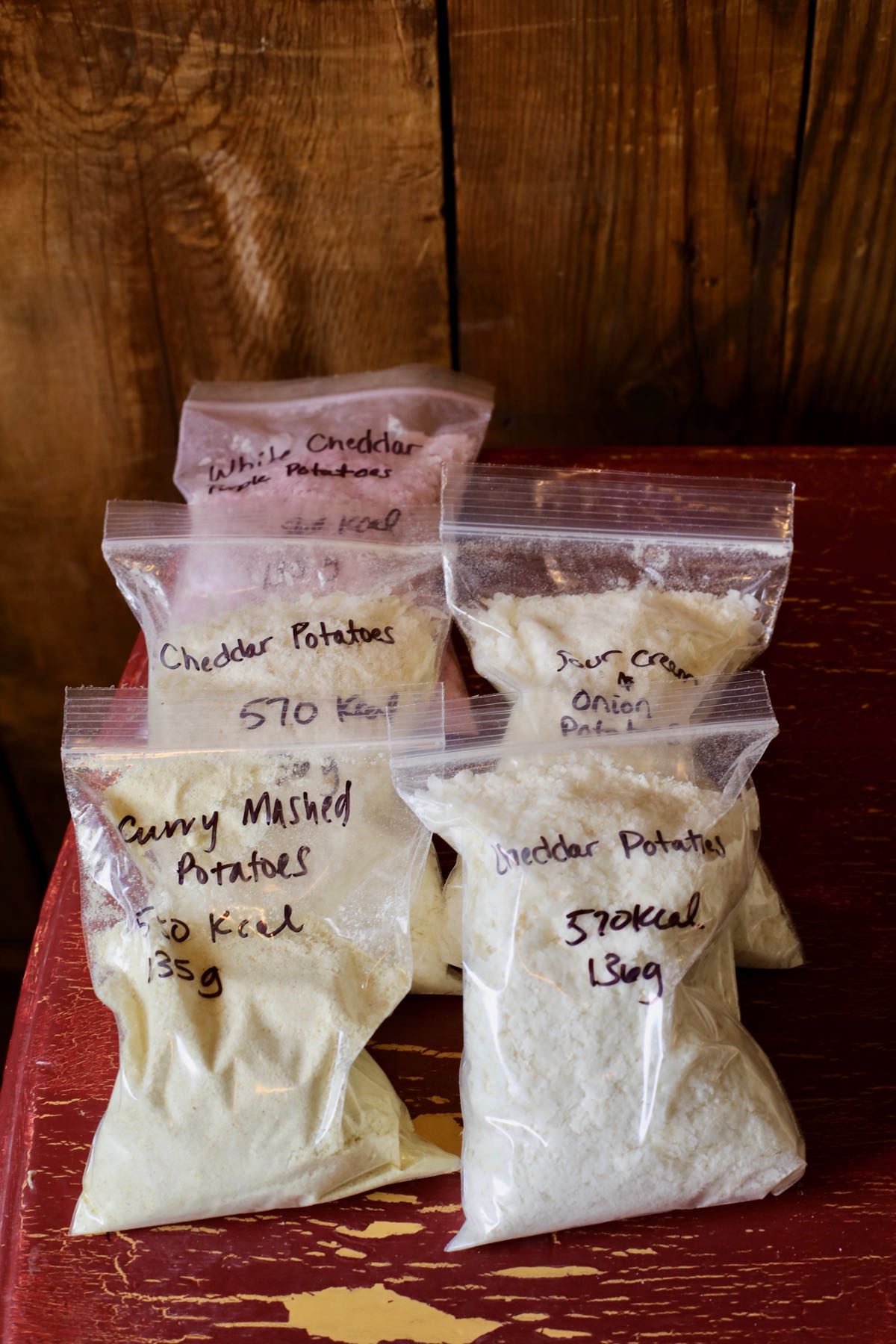
Homemade potato dinners made by GU Energy Labs’s Roxanne Vogel before packaging them into quart-size freezer bags.
Moving Food
The below graphic shows what I consumed while running Stage 5, the marathon-length stage, of MDS:
Here we arrive to what I think is the trickiest part of creating your MDS food list, choosing what you will consume during the stages themselves. Let me begin by saying that I am normally able to run the vast majority of MDS. Additionally, my years of endurance running at home have shown that I can digest between 250 and 300 kcals of mostly carbohydrate-based running fuel per hour, and that this leads to good energy levels for endurance running. At the calorie-restricted MDS, I plan for a minimum of 200 kcals/hour of carbohydrate-based running fuel. At home in the months leading up to MDS, I train with fewer than 250 kcals/hour on long runs, usually something in the 100 to 200 kcals/hour range, so that I can run with success on 200 kcals/hour at MDS.
You’ll see on my food list that the amount of food I packed for each day of running varied, and this was based upon how long I thought each stage would take me to run. MDS participants learn the length and layout of each stage during the long bus ride out to the starting-line bivouac, only two days before the race begins. As such, I bring with me to the starting-line bivouac plenty of running food, and then shift it into position once I see the layout and distance of each stage and can estimate how long each will take me to run.
Next, I consider the water element of running food, and how to minimize it as best as I am able. Running gels and chews have significant water weight, while powders do not. This is why I chose the GU Energy Labs Roctane Drink Mix for the majority of my running fuel as it comes in powder form. I incorporated GU Energy Labs Chews too because I have found that putting something slightly solid into my stomach during long runs keeps me from having hunger pangs. Additionally, I think it’s important for me to ingest multiple forms and flavors of fuel while running for so many hours in one week.
Of note, I did not repackage any of my moving food into ultralight plastic bags. While the original packaging of the drink mix was a bit heavier than I would like, I was nervous about accidentally ripping an ultralight bag while trying to quickly refill bottles while racing. In the end, I decided that the extra packaging weight was worth it in durability.
I can’t emphasize enough the ‘you are a study of one’ principle here. In my now six MDS runs, the food I consume while running has changed the most among everything on my MDS food list. My needs and palette have changed through time, and so does my food.
Other Details
At MDS, runners provide their own food starting on the morning of Stage 1 through the finish of Stage 6. You’ll see in my food list that I don’t have Stage 1’s breakfast listed. While that breakfast counts toward the minimum calorie requirements in the race rules, I don’t include it on my food list because I eat it before we run and because I bring well over 14,000 kcals and don’t need to include it to reach the required total. I ate the same breakfast before Stage 1 as the other days, with the addition of a fresh banana that I brought with me to the starting-line bivouac.
You’ll notice that, on Stage 6, I am carrying almost 1,400 kcals of powdered butter. The race rules mandate you to have 2,000 kcals of food left when you wake up on the morning of Stage 6. Of course, I didn’t eat the butter but carried it to fulfill the race requirements.
As seen on the food list, my total calorie count was 18,121 kcals and it weighed 4,532 grams.
Call for Comments
- If you have run MDS before or you are planning to run it soon, leave a comment to share what you’ve learned and experienced when it comes to food you eat at the race.
- Leave a comment to share links to blog posts or articles you’ve created about your MDS food list or that really helped you in planning for MDS in the past. The more information we can gather and share, the better prepared future MDS runners can be.
- Are you running MDS in the near future? What MDS food-list questions do you have? Leave your questions here and we’ll try to answer them. Also, if you’ve run MDS before, feel free to share your expertise and answer questions.
The Full Spreadsheet
Below is my complete 2019 MDS food list. Alternately, click over to my public Google Sheet to view it. Please note that the embedded Google Sheet below only shows the first sheet, my full food list, while the spreadsheet over in Google Sheets contains all seven sheets, six of which are nutrition labels for the homemade foods made by Roxanne Vogel.
